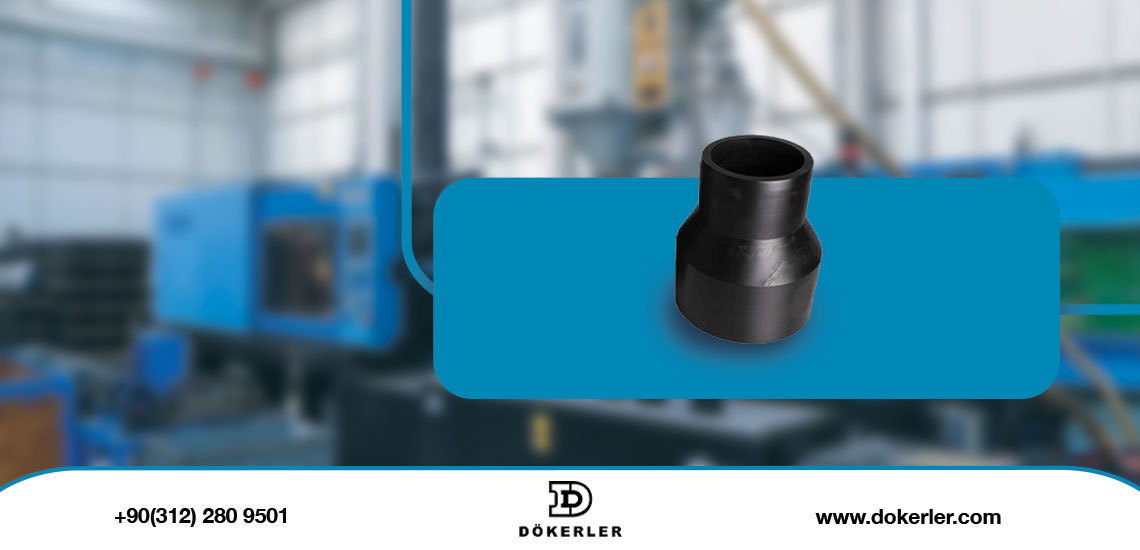
What is HDPE Injection Molded Fittings?
It is a method of shaping the plastic melted at a certain temperature by injecting it into the mold. HDPE pipe fittings produced by injection are the fittings that enable the connection of the main pipes used in gas and pressurized liquid plumbings, which are effective in determining the direction and size of the projects.
If safe techniques are not used in the connection of pipes and fittings, the consequences can be extremely bad and cause major accidents.
HDPE pipes and fittings for that enable the transportation of different gases and liquids, can also be used for the transportation of potentially threatening substances. Since these HDPE pipes are durable and long-lasting, they can be used for the transmission of hazardous wastes, chemicals and gases. HDPE fittings should be equally robust with HDPE pipes to avoid problems with infrastructure systems.
In addition, HDPE pipes and fittings do not require repair and renovation for a long time. Thus, it provides the opportunity to save both time and money. In this way, the disruption of the service of pipe plumbing and infrastructure problems are prevented.
Let’s get to know the HDPE injection molded fittings that play an important role in determining the flow direction of gas and pressurized liquid plumbing, balancing the speed, and the size of the project.
What are the Types of HDPE Injection Molded Fittings?
HDPE injection molded fitting types vary according to the project drawings of the plumbing and where they will be used. Each fitting has different tasks according to the projects it is involved in. Before we get into what these tasks are, we need to get to know the products themselves.
Although the HDPE fittings produced by injection molding are small in themselves, their role in the plumbing in which they are located is extremely big. From where to where the project can extend, changing the flow direction, opening different lines depend on these HDPE fittings.
The types of HDPE fittings produced by injection molding are as follows:
- HDPE Reducer
- HDPE Elbow
- HDPE Equal Tee
- HDPE Reduced Tee
- HDPE Flange Adaptor
- HDPE End Cap
All of these products undertake different tasks at different points in projects. Since, the HDPE fittings have an extremely easy and fast application; they make great contributions to the installation and contribution to the plumbing. In this way, time and money are saved by accelerating projects.
Let’s examine in detail what tasks HDPE fittings produced by injection molding method undertake in projects and their intended use.
For What Purposes are HDPE Injection Molded Fitting Types Used?
Pipe fittings produced by injection molding are used in infrastructure systems that transport various gases and pressurized liquids. HDPE fittings are indispensable for HDPE infrastructure pipe projects.
We have learned above what are the types of fittings that determine the direction and size of the projects. Now we will examine the duties of these fittings. Each of the fittings in the infrastructure system fulfills a different function. These are as follows:
- HDPE Reducer: HDPE injection molded reducer is used for joining large diameter pipes with small diameter pipes. Thanks to this fitting, the diameter of the pipelines can be easily changed. There are no sudden changes in the flow rate and dosage of the liquid.
- HDPE Elbow: It is used to change the flow direction of pipes. It is also widely used in hilly and sloping areas. Depending on the installation of the installation, there are different angle types such as 90º, 60º, 45º, 30º.
- HDPE Equal Tee: The product named after its shape is used to connect 3 separate pipes of the same diameter.
- HDPE Reduced Tee: It is a type of product that enables the connection of 2 pipes of the same diameter and volume and a pipe of different diameter within the project. It is an additional part that allows pipelines coming from different directions to be combined in one place or to create different lines.
- HDPE Flange Adaptor: It is produced by injection molding method, this fitting enables the connection of HDPE pipe and different pipe types with flange.
- HDPE End Cap: This fitting plays a role in the termination of the plumbing. It is an injection molded fitting used to close the pipe at the end of the plumbing.
Let’s look at the plumbing in which the injection molding fittings that perform all these activities are used.
Why Use HDPE Injection Molded Fitting?
Pressure resistance and long service life are among the biggest advantages of HDPE injection molded fittings. Connecting HDPE fittings produced by injection method to pipes also ensures the safety of the plumbing. There is no leakage in the piping systems or a situation such as breaking of the connections due to high pressure effect.
Build your plumbing projects with Dökerler assurance. With more than 80 years of experience and our open attitude to innovations, we produce our fittings. You can visitDökerler’s official website for detailed information about our injection molding product range.


